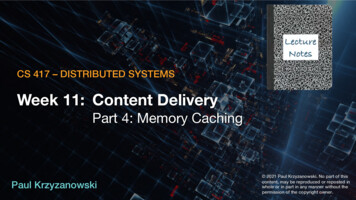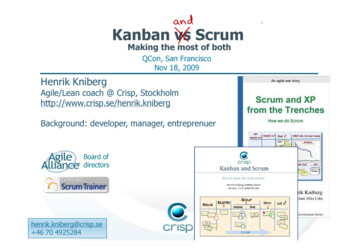
Transcription
CS 417 – DISTRIBUTED SYSTEMSWeek 11: Content DeliveryPart 4: Memory CachingPaul Krzyzanowski 2021 Paul Krzyzanowski. No part of thiscontent, may be reproduced or reposted inwhole or in part in any manner without thepermission of the copyright owner.
CachingPurpose of a cache Temporary storage to increase data access speeds Increase effective bandwidth by caching most frequently used dataStore raw data from slow devices Memory cache on CPUs Buffer cache in operating system Chubby file data and metadata GFS master caches all metadata in memoryStore computed data Avoid the need to look the same thing up again– Results of database queries or file searches– Spark RDDs in memoryNovember 15, 2021CS 417 2021 Paul Krzyzanowski2
What would you use a caching service for?Cache user session state on web application serversNo need to have user come back to the same computerCache user preferences, shopping carts, etc.Avoid repeated database lookups (e.g., key-value data)Cache rendered web pagesAvoid re-processing server-side includes, JSP/ASP/PHP code\Cache precomputed resultsAvoid re-computing data that gets reused(Spark RDDs, news posts, inventory status, )November 15, 2021CS 417 2021 Paul Krzyzanowski3
Distributed In-Memory Caching as a ServiceA network memory-based caching serviceShared by many – typically used by front-end servicesStores frequently-used (key, value) dataOld data gets evictedGeneral purposeNot tied to a specific back-end serviceBecause it’s a general-purpose service, the programmer gets involvedndt fou reif no ook helthenNot transparent (usually)look here Back-endserviceNovember 15, 2021CS 417 2021 Paul Krzyzanowski4
Deployment ModelsSeparate caching serverOne or more computers whose sole purpose is to provide a caching serviceUser-facing ServiceCache serverUser-facing ServiceCache serverUser-facing ServiceCache serverOr share cache memory among serversTake advantage of free memory from lightly-loaded nodesNovember 15, 2021User-facing ServiceCache serverUser-facing ServiceCache serverUser-facing ServiceCache serverCS 417 2021 Paul Krzyzanowski5
Example: memcachedFree & open source distributed memory cachingUsed byDropbox, Facebook, Wikipedia, Flickr, Twitter,YouTube, Instagram, Digg, Bebo, WordPress, Craigslist, Protocolmemcached.orgBinary & ASCII versionsClient APIs forCommand line, C/C , C#, Go, PHP, Java, Python, Ruby, Perl, Erlang, Lua, LISP,Windows/.NET, mySQL, PostgreSQL, ColdFusion, November 15, 2021CS 417 2021 Paul Krzyzanowski6
Memcached structureKey-Value store– Cache is made up of { key, value, expiration time, flags }– All access is O(1)Client software– Provided with a list of memcached servers– Hash(key) chooses a server based on the keyServer software– Stores keys and values in an in-memory hash table– Throw out old data when necessary LRU cache and time-based expiration Objects expire after a minute to ensure stale data is not returned– Servers are unaware of each otherNovember 15, 2021CS 417 2021 Paul Krzyzanowski7
Memcached APICommands sent over TCP (UDP also available)Connection may be kept open indefinitelyCommandsStorage Storage commands take an expiration time in seconds fromcurrent time or 0 forever (but may be deleted) set – store data add – store data only if the server does not have data for the key replace – store data if the server does have data for the key append – add data after existing data prepend – add data before existing data cas – check & set: store data only if no one else updated it since I fetched it(cas unique, 64-bit value associated with the item)Retrieval get – retrieve one or more keys: returns key, flags, bytes, and cas uniqueNovember 15, 2021CS 417 2021 Paul Krzyzanowski8
Memcached APICommandsDeletion delete keyIncrement/decrement Treat data as a 64-bit unsigned integer and add/subtract value incr key value – increment key by value decr key value – decrement key by valueUpdate expiration touch key exptime – Update the expiration timeGet Statistics stats – various options for reporting statisticsFlush flush all – clear the cacheNovember 15, 2021CS 417 2021 Paul Krzyzanowski9
RedisMemory cache in-memory database message brokerOpen source: see redis.ioText-based command interfaceFeatures––––––––Key-value storeTransactionsPublish/subscribe messagingExpiration of dataBuilt-in replicationOptional disk persistenceLua scripting (via EVAL command)Automatic partitioning with Redis ClusterUsed by: Twitter, GitHub, Weibo, Pinterest, Snapchat, Craigslist, Digg, StackOverflow, Flickr, Shopify, Hulu, Trello, Uber,Coinbase, November 15, 2021CS 417 2021 Paul Krzyzanowski10
Redis Data TypesStringsHashes– Simplest type; only type supported inmemcached)– Maps of fields associated with values(fields & values are strings)ListsBitmaps– Collections of strings sorted by order ofinsertion– Commands to treat strings as bits(set/clear bits)SetsHyperLogLogs– Collections of unique, unsorted strings– Probabilistic data structure to estimate thecardinality of a setSorted sets– Every element is associated with a score(floating point number)– Elements sorted by score– Operations to retrieve ranges (e.g., top 10,bottom 10)November 15, 2021 Count # of unique items without storingthe entire set of items– Use a fixed amount of memoryCS 417 2021 Paul Krzyzanowski11
Redis as a memory cache: Timeouts & EvictionsSet expiration for specific keys– Associate a timeout with a key– Key deleted after the timeoutSET mykey “hello”EXPIRE mykey 10expire key in 10 secondsTell the cache to automatically evict (delete) old dataMethods of eviction LRU (least recently used)LRU only for keys that have an expiration timeRandomRandom only for keys that have an expiration timeNovember 15, 2021CS 417 2021 Paul Krzyzanowski12
Redis as an in-memory databaseMULTI– Mark the start of a transaction (operations queued until EXEC)EXEC– Execute queued commands in a transactionDISCARD– Abort transaction & revert to previous valuesWATCH– Test-and-set behavior to ensure mutual exclusion– Monitor keys to detect changes– Abort if change takes placeNovember 15, 2021CS 417 2021 Paul Krzyzanowski13
Redis as a message brokerPublish/subscribe model– Senders (publishers) do not send messages to specific receivers– Messages go to channels– Subscribers listen to one or more channels, receiving messages of interestAllows for scalability and dynamic topology– Publishers do not know subscribers– Subscribers do not know publishersSupport for pattern-based channels– Subscribe to all channel names matching a patternNovember 15, 2021CS 417 2021 Paul Krzyzanowski14
Redis partitioningData can be partitioned across multiple computersTypes of partitions Range partitioning– Use table that maps ranges to instances Hash partitioning– Based on hash(key): works with any keyWho does the partitioning? Client-side partitioning Proxy-assisted partitioning Query forwarding by a Redis serverNovember 15, 2021CS 417 2021 Paul Krzyzanowski15
The EndNovember 15, 2021CS 417 2021 Paul Krzyzanowski16
Or share cache memory among servers Take advantage of free memory from lightly-loaded nodes 5 User-facing Service User-facing Service User-facing Service Cache server . Memory cache in-memory database message broker Open source: see redis.io Text -based command interface Features - Key-value store - Transactions










